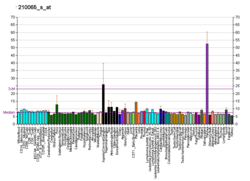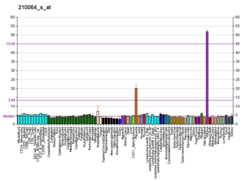Uroplakin 1B, also known as UPK1B, is a protein which in humans is encoded by the UPK1B gene.[5][6][7]
Function
The protein encoded by this gene is a member of the transmembrane 4 superfamily, also known as the tetraspanin family. Most of these members are cell-surface proteins that are characterized by the presence of four hydrophobic domains. These proteins mediate signal transduction events that play a role in the regulation of cell development, activation, growth and motility. This encoded protein is found in the asymmetrical unit membrane (AUM) where it can form a complex with other transmembrane 4 superfamily proteins. It may play a role in normal bladder epithelial physiology, possibly in regulating membrane permeability of superficial umbrella cells or in stabilizing the apical membrane through AUM/cytoskeletal interactions. The AUM is believed to be involved in strengthening the cells that line the bladder, and in enhancing the inner bladder membrane's ability to stretch, thus preventing these cells from rupturing during bladder distension. The use of alternate polyadenylation sites has been found for this gene.[5]
References
- 1 2 3 GRCh38: Ensembl release 89: ENSG00000114638 - Ensembl, May 2017
- 1 2 3 GRCm38: Ensembl release 89: ENSMUSG00000049436 - Ensembl, May 2017
- ↑ "Human PubMed Reference:".
- ↑ "Mouse PubMed Reference:".
- 1 2 "Entrez Gene: UPK1B uroplakin 1B".
- ↑ Lobban ED, Smith BA, Hall GD, Harnden P, Roberts P, Selby PJ, Trejdosiewicz LK, Southgate J (December 1998). "Uroplakin gene expression by normal and neoplastic human urothelium". Am. J. Pathol. 153 (6): 1957–67. doi:10.1016/S0002-9440(10)65709-4. PMC 1866332. PMID 9846985.
- ↑ Finch JL, Miller J, Aspinall JO, Cowled PA (February 1999). "Cloning of the human uroplakin 1B cDNA and analysis of its expression in urothelial-tumor cell lines and bladder-carcinoma tissue". Int. J. Cancer. 80 (4): 533–8. doi:10.1002/(SICI)1097-0215(19990209)80:4<533::AID-IJC9>3.0.CO;2-5. PMID 9935153.
Further reading
- Berditchevski F (2002). "Complexes of tetraspanins with integrins: more than meets the eye". J. Cell Sci. 114 (Pt 23): 4143–51. PMID 11739647.
- Maruyama K, Sugano S (1994). "Oligo-capping: a simple method to replace the cap structure of eukaryotic mRNAs with oligoribonucleotides". Gene. 138 (1–2): 171–4. doi:10.1016/0378-1119(94)90802-8. PMID 8125298.
- Wu XR, Medina JJ, Sun TT (1996). "Selective interactions of UPIa and UPIb, two members of the transmembrane 4 superfamily, with distinct single transmembrane-domained proteins in differentiated urothelial cells". J. Biol. Chem. 270 (50): 29752–9. doi:10.1074/jbc.270.50.29752. PMID 8530366.
- Finch JL, Webb GC, Evdokiou A, Cowled PA (1997). "Chromosomal localization of the human urothelial "tetraspan" gene, UPK1B, to 3q13.3-q21 and detection of a TaqI polymorphism". Genomics. 40 (3): 501–3. doi:10.1006/geno.1996.4589. PMID 9073521.
- Suzuki Y, Yoshitomo-Nakagawa K, Maruyama K, et al. (1997). "Construction and characterization of a full length-enriched and a 5'-end-enriched cDNA library". Gene. 200 (1–2): 149–56. doi:10.1016/S0378-1119(97)00411-3. PMID 9373149.
- Yuasa T, Yoshiki T, Tanaka T, et al. (1998). "Expression of uroplakin Ib and uroplakin III genes in tissues and peripheral blood of patients with transitional cell carcinoma". Jpn. J. Cancer Res. 89 (9): 879–82. doi:10.1111/j.1349-7006.1998.tb00643.x. PMID 9818021.
- Lobban ED, Smith BA, Hall GD, et al. (1998). "Uroplakin gene expression by normal and neoplastic human urothelium". Am. J. Pathol. 153 (6): 1957–67. doi:10.1016/S0002-9440(10)65709-4. PMC 1866332. PMID 9846985.
- Finch JL, Miller J, Aspinall JO, Cowled PA (1999). "Cloning of the human uroplakin 1B cDNA and analysis of its expression in urothelial-tumor cell lines and bladder-carcinoma tissue". Int. J. Cancer. 80 (4): 533–8. doi:10.1002/(SICI)1097-0215(19990209)80:4<533::AID-IJC9>3.0.CO;2-5. PMID 9935153.
- Ogawa K, Johansson SL, Cohen SM (1999). "Immunohistochemical analysis of uroplakins, urothelial specific proteins, in ovarian Brenner tumors, normal tissues, and benign and neoplastic lesions of the female genital tract". Am. J. Pathol. 155 (4): 1047–50. doi:10.1016/S0002-9440(10)65206-6. PMC 1867018. PMID 10514386.
- Olsburgh J, Weeks R, Selby P, Southgate J (2002). "Human uroplakin lb gene structure and promoter analysis". Biochim. Biophys. Acta. 1576 (1–2): 163–70. doi:10.1016/s0167-4781(02)00304-4. PMID 12031497.
- Deng FM, Liang FX, Tu L, et al. (2003). "Uroplakin IIIb, a urothelial differentiation marker, dimerizes with uroplakin Ib as an early step of urothelial plaque assembly". J. Cell Biol. 159 (4): 685–94. doi:10.1083/jcb.200204102. PMC 2173100. PMID 12446744.
- Tu L, Sun TT, Kreibich G (2003). "Specific heterodimer formation is a prerequisite for uroplakins to exit from the endoplasmic reticulum". Mol. Biol. Cell. 13 (12): 4221–30. doi:10.1091/mbc.E02-04-0211. PMC 138628. PMID 12475947.
- Strausberg RL, Feingold EA, Grouse LH, et al. (2003). "Generation and initial analysis of more than 15,000 full-length human and mouse cDNA sequences". Proc. Natl. Acad. Sci. U.S.A. 99 (26): 16899–903. doi:10.1073/pnas.242603899. PMC 139241. PMID 12477932.
- Varga AE, Leonardos L, Jackson P, et al. (2004). "Methylation of a CpG island within the uroplakin Ib promoter: a possible mechanism for loss of uroplakin Ib expression in bladder carcinoma". Neoplasia. 6 (2): 128–35. doi:10.1593/neo.03337. PMC 1502093. PMID 15140401.
- Gerhard DS, Wagner L, Feingold EA, et al. (2004). "The status, quality, and expansion of the NIH full-length cDNA project: the Mammalian Gene Collection (MGC)". Genome Res. 14 (10B): 2121–7. doi:10.1101/gr.2596504. PMC 528928. PMID 15489334.





